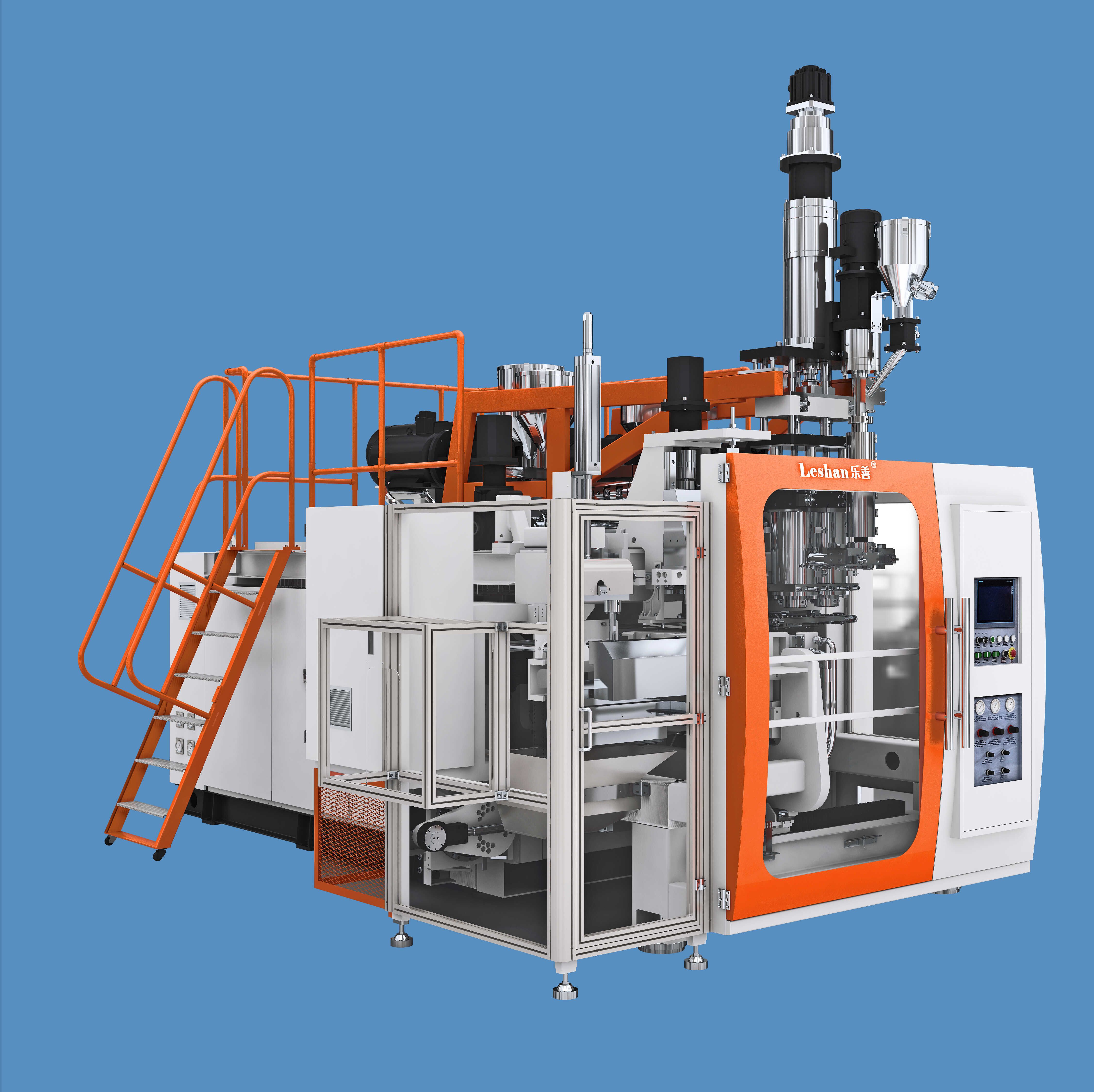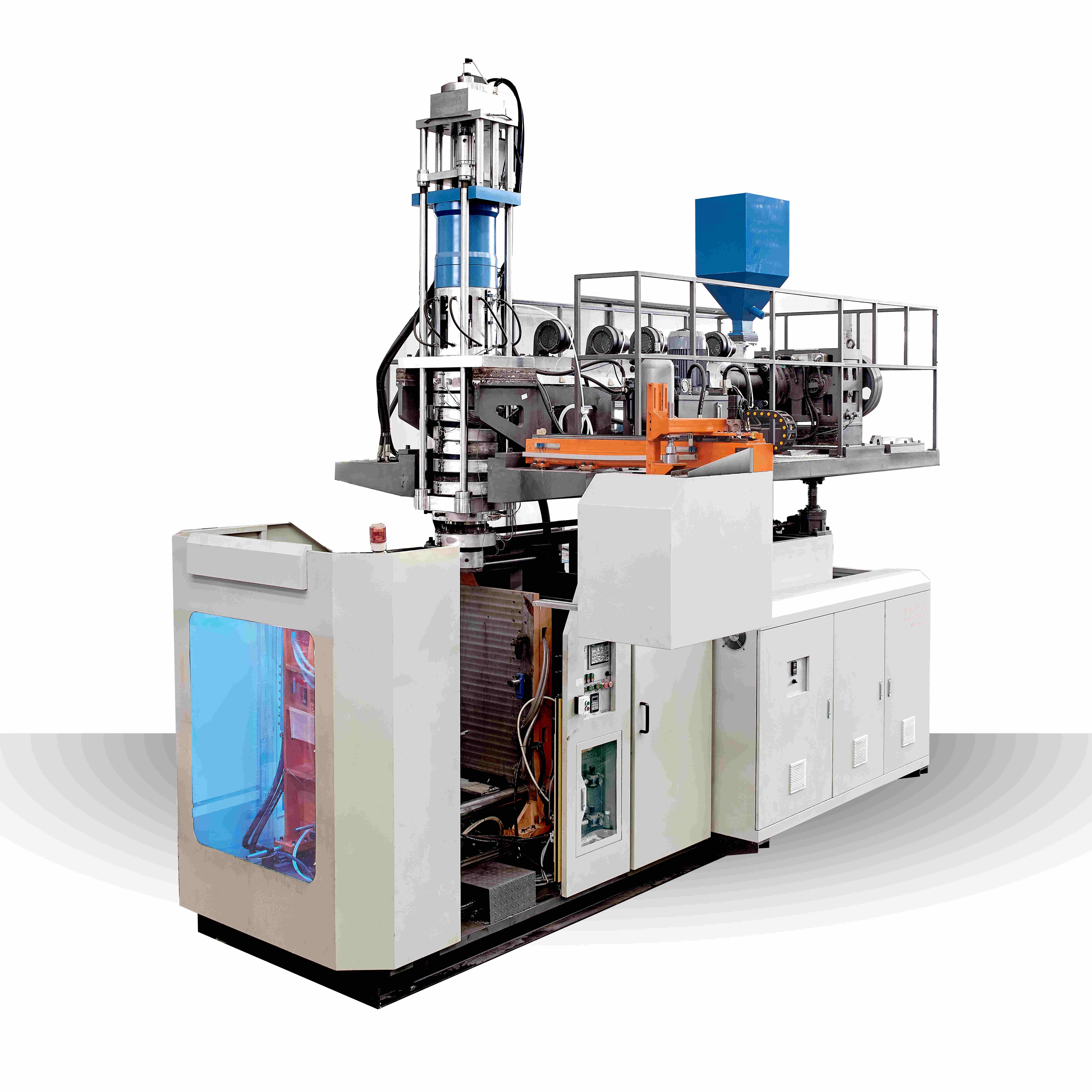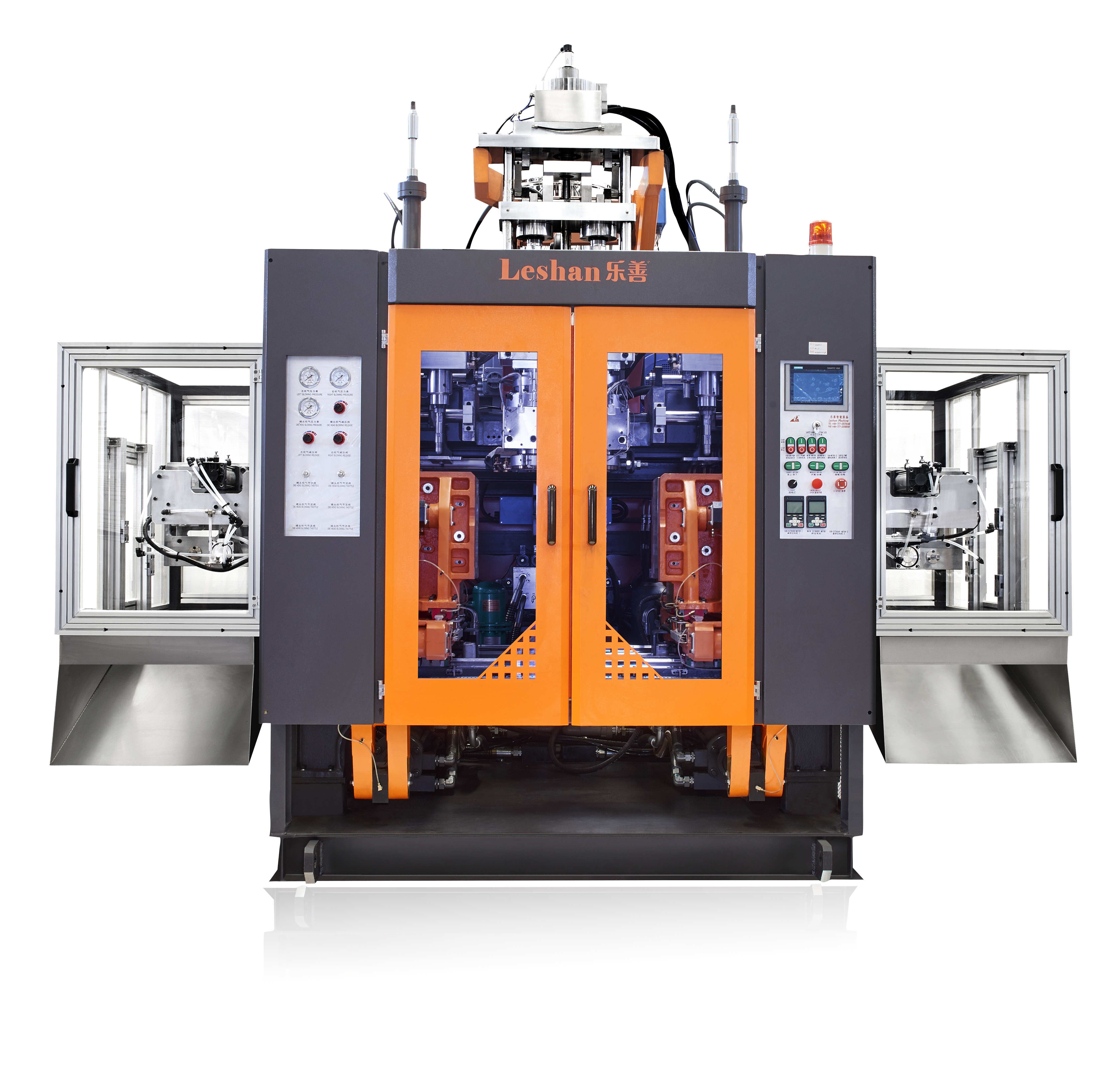
Blow Molding Extrusion
Blow Molding Extrusion
Guangdong Leshan Intelligent Equipment Corp.,Ltd, located in Foshan, Guangdong Province, China, was founded in 1995 and has 20 years of manufacturing and technical development experience in the field of blow molding machines. Our current products mainly include Cleaning bottle blow molding machine,multi-layer coextrusion blow molding machine,Engine oil bottle blow molding machine,Food bottle blow molding machine,Milk bottle blow molding machine,Irregular shape product blow molding machine,Extrusion Die Head,Auxiliary machine,Daily chemistry bottle blow molding machine,athlon series hydraulic machine,PET Machine, etc.We also use International standards and the ISO9001:2012 quality management system in producing.
LESHAN has Four axis CNC machining-center,Vertical CNC gantry machining-center,Pentahedron gantry machining center,Numerical-controlled knee bend machine and other specialized equipment. We have our own export rights and export our machines to various parts of the world.For example, countries such as Russia, Australia, Bangladesh, Vietnam, Philippines,Israel,Ethiopia,Wallis and Futuna, etc.Leshan Hydraulic Blow Molding Machine is adopted by many listed companies and China's top 500 enterprises, such as Liby,BlackCow Food,Wahaha,Walch,Kunlun,Sinopec,Bawang,Monarch,Yili, ect.
| Parameter | Information |
|---|---|
| Product Name | blow molding extrusion |
| Brand Name | Leshan |
| Place of Origin | Foshan,Guangdong,China |
| Plastic Processed | PVC,ABS,PP,PC,HDPE,EVA,Polystyrene...etc |
| Air Pressure(MPa) | 0.8 MPa |
| Color | Customized Color |
| Delivery Time | 45 days |
| Port | ShunDe/GuangZhou/ShenZhen China |
| Export region | Asia,Oceania,Africa |
| Export Country | Russia, Australia, Poland,Kazakhstan,Niger,Western Sahara...etc |
| Application | Bottle |
| OEM/ODM | Support |
| Core Components | Pressure vessel,Engine,Bearing,Motor,Gear...etc |
| Voltage | 380V |
| Service | Video technical support... |
| MOQ | 1 set |
| Certification | ISO9001,CE... |
| Supply Ability | 500 Set/Sets per Month |
| Weight (T) | 5-18(According to specific model) |
| Packaging Details | Standard exporting machine packing with plastic film |
| Lead time (days) | 70 (To be negotiated) |
Please note: The above table data is for reference only. For specific information, please contact us.

As a commonly used plastic processing machine, blow molding extrusion has the characteristics of powerful functions and easy operation. It can complete the heating, plasticizing, blowing, cooling and other processes of plastic in one mold feeding and molding process, thereby making the product lightweight, durable, transparent and other advantages.
At the same time, the blow molding machine also has high production efficiency, can continuously produce large quantities of products, and is suitable for manufacturing plastic containers of various specifications and shapes.

blow molding extrusion---FAQs Guide
2.How do blow molding extrusion manufacturers control variables like temperature, pressure, and blow time in the blow molding process to ensure consistent product quality?
3.What are the steps for cleaning and maintaining a blow molding extrusion?
4.Which industries can apply blow molding extrusion?
5.How to design the shaping mold for blow molding extrusion?
6.What are the advantages of Leshan blow molding machine?
7.What is the after-sales service for blow molding extrusion?
8.How to adjust the production speed of blow molding extrusion?
9.What is the working principle of a blow molding machine?
1.What is the operating cost of a blow molding extrusion?
We attach importance to the innovation ability and team spirit of employees, have advanced R & D facilities and laboratories, and have a good quality management system.
The operating cost of a blow molding machine can vary depending on factors such as the size and type of machine, the materials being used, and the production volume. However, some common operating costs include:
1. Energy costs: Blow molding machines require a significant amount of energy to operate, including electricity for heating and cooling processes. The cost of energy can vary depending on the location and the efficiency of the machine.
2. Labor costs: The cost of labor includes the wages of operators and technicians who run the machine, as well as any maintenance or repair personnel.
3. Material costs: The cost of materials, such as plastic resins, can vary depending on the type and quality of the material being used.
4. Maintenance and repair costs: Regular maintenance and occasional repairs are necessary to keep the machine running smoothly, and these costs should be factored into the overall operating cost.
5. Overhead costs: This includes expenses such as rent, insurance, and administrative costs that are necessary for the operation of the machine.
Overall, the operating cost of a blow molding machine can range from a few hundred dollars per day for a small machine to thousands of dollars per day for a large, high-volume machine.
2.How do blow molding extrusion manufacturers control variables like temperature, pressure, and blow time in the blow molding process to ensure consistent product quality?
We pay attention to the transformation of intellectual property protection and innovation achievements. Your OEM or ODM order design we have a complete confidentiality system.
1. Temperature Control: Blow molding machines have heating elements that are used to heat the plastic material to a specific temperature before it is blown into the mold. The temperature is controlled by sensors and thermostats that monitor and adjust the temperature as needed. This ensures that the plastic material is at the optimal temperature for the blow molding process, which helps to produce consistent product quality.
2. Pressure Control: The pressure in the blow molding process is controlled by the air pressure in the mold. The blow molding machine has a pressure regulator that controls the amount of air that is blown into the mold. This pressure is monitored and adjusted to ensure that it is consistent throughout the molding process. This helps to ensure that the plastic material is evenly distributed and that the final product has consistent wall thickness.
3. Blow Time Control: The blow time refers to the amount of time that the air is blown into the mold to inflate the plastic material. This is a critical variable in the blow molding process as it determines the final shape and size of the product. Blow molding machines have timers that control the duration of the blow time, and these can be adjusted to ensure consistent product quality.
4. Process Monitoring: Blow molding machine manufacturers also use advanced process monitoring systems to track and control the variables in the blow molding process. These systems use sensors and software to monitor and adjust the temperature, pressure, and blow time in real-time. This helps to ensure that any variations in these variables are immediately detected and corrected, resulting in consistent product quality.
5. Quality Control: In addition to controlling the variables during the blow molding process, manufacturers also have quality control measures in place to ensure consistent product quality. This includes regular testing and inspection of the final products to check for any defects or variations. Any issues are identified and addressed to maintain the desired level of product quality.
3.What are the steps for cleaning and maintaining a blow molding extrusion?
We adhere to the principle of integrity and transparency, and establish long -term relationships with partners, and we attach great importance to this detail.
1. Shut off and unplug the machine: Before starting any cleaning or maintenance, make sure the machine is turned off and unplugged to avoid any accidents.
2. Remove excess material: Use a scraper or a brush to remove any excess material from the machine, including the mold, extruder, and die head.
3. Disassemble the machine: Depending on the type of blow molding machine, you may need to disassemble certain parts to access all the areas that need cleaning. Refer to the manufacturer's manual for specific instructions.
4. Clean the mold: Use a mild detergent and warm water to clean the mold. Make sure to remove any residue or buildup from the mold surface. You can also use a specialized mold cleaner for tougher stains.
5. Clean the extruder and die head: Use a brush or scraper to remove any residue or buildup from the extruder and die head. You can also use a specialized cleaner for these parts.
6. Check and clean the cooling system: The cooling system is essential for maintaining the temperature of the machine. Check for any clogs or buildup in the cooling channels and clean them with a brush or compressed air.
7. Lubricate moving parts: Use a lubricant recommended by the manufacturer to lubricate all the moving parts of the machine. This will help prevent wear and tear and ensure smooth operation.
8. Inspect and replace worn parts: Check all the parts of the machine for any signs of wear and tear. Replace any damaged or worn parts to ensure the machine's optimal performance.
9. Reassemble the machine: Once all the parts are cleaned and inspected, reassemble the machine following the manufacturer's instructions.
10. Test the machine: Before using the machine again, run a test cycle to ensure everything is working correctly.
11. Regular maintenance: To keep the machine in good working condition, it is essential to perform regular maintenance tasks such as cleaning, lubricating, and inspecting the machine. Refer to the manufacturer's manual for a recommended maintenance schedule.
4.Which industries can apply blow molding extrusion?
Being one of the top blow molding extrusion manufacturers in China, We attach great importance to this detail.
1. Packaging industry: Blow molding machines are commonly used in the packaging industry to produce plastic bottles, containers, and other packaging materials.
2. Automotive industry: Blow molding machines are used to produce various automotive components such as fuel tanks, air ducts, and bumpers.
3. Consumer goods industry: Many consumer goods such as toys, household items, and personal care products are made using blow molding machines.
4. Medical industry: Blow molding machines are used to produce medical devices and equipment such as IV bags, syringes, and medical tubing.
5. Construction industry: Blow molding machines are used to produce large plastic tanks, pipes, and other construction materials.
6. Agriculture industry: Agricultural products such as irrigation pipes, water tanks, and seedling trays are produced using blow molding machines.
7. Electronics industry: Blow molding machines are used to produce plastic casings and components for electronic devices.
8. Furniture industry: Blow molding machines are used to produce plastic furniture components such as chairs, tables, and storage units.
9. Sports and recreation industry: Many sports and recreation products such as kayaks, surfboards, and playground equipment are made using blow molding machines.
10. Aerospace industry: Blow molding machines are used to produce lightweight and durable components for aircraft and spacecraft.

5.How to design the shaping mold for blow molding extrusion?
We continuously upgrade our skills and knowledge to adapt to changing blow molding extrusion market needs.
1. Determine the shape and size of the final product: The first step in designing a shaping mold for blow molding machines is to determine the shape and size of the final product. This will help in determining the overall dimensions and features of the mold.
2. Choose the type of blow molding machine: There are different types of blow molding machines such as extrusion blow molding, injection blow molding, and stretch blow molding. Each type requires a different type of mold design, so it is important to choose the right type of machine for your product.
3. Create a 3D model of the product: Using CAD software, create a 3D model of the product to be molded. This will help in visualizing the final product and identifying any potential design issues.
4. Determine the number of cavities: The number of cavities in the mold will depend on the production volume and the size of the product. More cavities will increase the production rate, but it will also increase the complexity and cost of the mold.
5. Design the core and cavity: The core and cavity are the two main components of the mold. The core is the inner part of the mold that shapes the product, while the cavity is the outer part that gives the product its final shape. The design of these components should be precise and accurate to ensure a high-quality product.
6. Consider draft angles: Draft angles are important in blow molding as they allow the product to be easily removed from the mold. A draft angle of 3-5 degrees is recommended for most products.
7. Add cooling channels: Cooling channels are essential for maintaining the temperature of the mold during the molding process. These channels should be strategically placed to ensure uniform cooling and prevent warping of the product.
8. Include ejection system: An ejection system is used to remove the product from the mold after it has been formed. This can be in the form of pins, air blasts, or mechanical ejection systems.
9. Test and refine the design: Once the initial design is complete, it is important to test it on a prototype mold to identify any design flaws or issues. This will help in refining the design before the final mold is produced.
10. Consider material selection: The material used for the mold should be able to withstand high temperatures and pressures. Common materials used for blow molding molds include aluminum, steel, and beryllium copper.
11. Work with a professional mold maker: It is recommended to work with a professional mold maker who has experience in designing molds for blow molding machines. They can provide valuable insights and ensure that the mold is designed to meet your specific requirements.
6.What are the advantages of Leshan blow molding machine?
High cost performance, moderate price, more after-sales service coverage, high insurance rate, strong durability of the machine.
7.What is the after-sales service for blow molding extrusion?
We are centered on customers and always pay attention to customers' needs for blow molding extrusion products.
The after-sales service for blow molding machines typically includes:
1. Technical support: This includes troubleshooting assistance, repair guidance, and advice on machine maintenance and operation.
2. Spare parts supply: The manufacturer or supplier should have a stock of spare parts for the blow molding machine, and be able to provide them quickly when needed.
3. Training: The manufacturer or supplier may offer training programs for operators and maintenance personnel to ensure proper use and maintenance of the machine.
4. Warranty: Most blow molding machines come with a warranty period, during which any defects or malfunctions will be repaired or replaced by the manufacturer or supplier.
5. On-site support: In case of major issues or breakdowns, the manufacturer or supplier may send a technician to the customer's site to provide on-site support and repairs.
6. Upgrades and improvements: The manufacturer or supplier may offer upgrades or improvements to the machine to enhance its performance or add new features.
7. Customer service: A good after-sales service should also include prompt and helpful customer service to address any concerns or questions the customer may have.
Overall, the after-sales service for blow molding machines should ensure that the customer's machine is running smoothly and efficiently, and any issues are resolved quickly to minimize downtime.
8.How to adjust the production speed of blow molding extrusion?
Our blow molding extrusion products undergo strict quality control to ensure customer satisfaction.
1. Check the machine settings: The first step in adjusting the production speed of a blow molding machine is to check the machine settings. Make sure that the machine is set to the desired production speed and that all the necessary adjustments have been made.
2. Adjust the air pressure: The air pressure is a crucial factor in the production speed of a blow molding machine. Increasing the air pressure can help to speed up the production process, while decreasing it can slow it down. Adjust the air pressure according to the desired production speed.
3. Change the mold: The size and shape of the mold can also affect the production speed. A larger or more complex mold will take longer to produce, while a smaller and simpler mold will speed up the production process. Consider changing the mold to one that is more suitable for the desired production speed.
4. Increase or decrease the parison size: The parison is the hollow tube of plastic that is formed in the machine and then blown into the mold. Adjusting the size of the parison can also affect the production speed. Increasing the parison size will result in a larger product and slower production, while decreasing the parison size will result in a smaller product and faster production.
5. Adjust the cooling time: The cooling time is the amount of time the product spends in the mold to solidify. Increasing the cooling time will slow down the production speed, while decreasing it will speed it up. Adjust the cooling time according to the desired production speed.
6. Check for any mechanical issues: If the production speed is not adjusting as expected, it is important to check for any mechanical issues with the machine. Make sure that all the components are functioning properly and that there are no obstructions or malfunctions that could be slowing down the production speed.
7. Test and adjust: Once all the necessary adjustments have been made, run a test production to see if the desired speed has been achieved. If not, make further adjustments until the desired production speed is reached.
It is important to note that adjusting the production speed of a blow molding machine may require some trial and error. It is recommended to make small adjustments at a time and test the results before making further adjustments.

9.What is the working principle of a blow molding machine?
We focus on innovation and continuous improvement to maintain a competitive advantage.
The working principle of a blow molding machine involves the use of compressed air to inflate a molten plastic tube or parison inside a mold cavity. This creates a hollow shape that is then cooled and solidified to form a plastic product.
The process begins with the plastic material, usually in the form of pellets, being fed into a hopper and then melted in an extruder. The molten plastic is then forced into a long tube or parison, which is then clamped between two halves of a mold.
Next, a nozzle is inserted into the parison and compressed air is blown into it, causing the plastic to expand and take the shape of the mold cavity. The mold is cooled to solidify the plastic, and then the mold halves are separated, and the finished product is ejected.
The blow molding process can be either extrusion blow molding or injection blow molding, depending on the type of machine used. In extrusion blow molding, the parison is formed by extruding the molten plastic through a die, while in injection blow molding, the parison is formed by injecting the molten plastic into a mold cavity.
The working principle of a blow molding machine is based on the principles of thermodynamics and fluid mechanics, where the expansion of compressed air inside the parison creates pressure that forces the plastic to take the shape of the mold. This process allows for the production of hollow plastic products with complex shapes and sizes.
Tags: extrusion blowing moulding machine,oil blow molding machine
